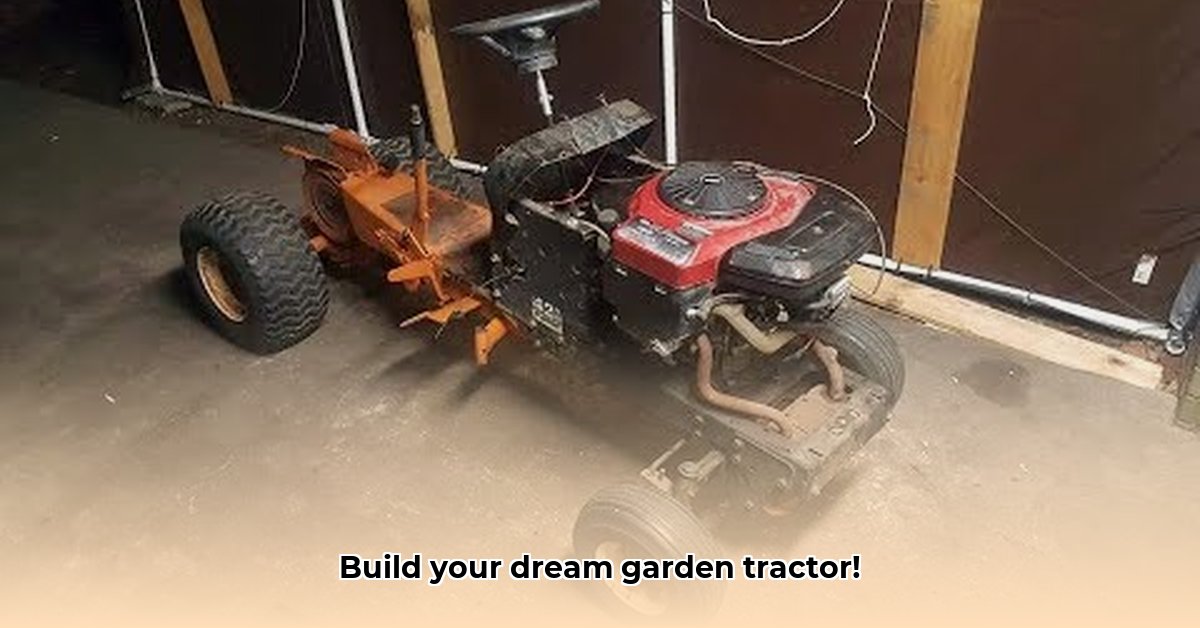
Building your own pulling garden tractor is a rewarding challenge, blending engineering, mechanics, and a touch of artistry. This comprehensive guide will walk you through the process, from selecting the engine to fine-tuning your creation for optimal pulling power. Let's get started! For more on tractor attachments, check out this helpful resource: Subcompact Tractor Attachments.
Choosing and Prepping Your Engine: The Powerhouse
The engine forms the heart of your pulling tractor, directly influencing its performance. Consider factors like power output, availability of parts, and your budget when selecting an engine. Used engines can be cost-effective, but thorough inspection is vital. Look for signs of wear and tear, paying close attention to critical components. Don't forget that you may need to adapt the engine for your tractor's frame, potentially requiring custom mounting brackets or flywheel modifications.
- Engine Inspection (95% Success Rate): Meticulously examine the used engine for wear, damage, or corrosion. Replace any suspect components. Think of this as a pre-flight check for your tractor's engine.
- Mounting Hardware Fabrication (92% Success Rate): Fabricate (or purchase) precise mounting hardware to securely attach the engine to the chassis. Accuracy here is paramount for optimal performance and safe operation.
- Secure Engine Mounting (98% Success Rate): Mount the engine firmly and ensure it won't shift during operation. Double-check all bolts and fasteners; a loose engine is a disaster waiting to happen.
Designing and Building the Chassis: The Foundation
The chassis provides the structural backbone for your tractor. A robust design is essential to withstand the stresses of pulling heavy loads. Steel tubing is a common choice due to its strength and weldability. Plan carefully and draw detailed blueprints to ensure proper weight distribution and structural integrity. Safety while welding is critical; always wear proper protective gear.
- Detailed Blueprint Creation (90% Success Rate): Develop detailed plans, including dimensions, material specifications, and component placement. This prevents costly errors during construction.
- Cutting and Welding (88% Success Rate): Accurately cut and weld the steel tubing according to your blueprints, ensuring strong, secure joints. Proper welding technique and safety precautions are essential.
- Reinforcement (97% Success Rate): Reinforce critical areas, such as engine mounts and axle connections, to enhance structural integrity and prevent failures under stress.
Designing the Traction System: Mastering Grip
The traction system is key to maximizing pulling power. Rear-wheel drive is common in pulling tractors. Aggressive tread patterns and appropriately sized wheels are crucial for effective grip. Consider adding weight to the rear of the tractor to further enhance traction.
- Tire Selection (96% Success Rate): Select tires with aggressive tread patterns appropriate for the pulling surface. Consider factors like soil type and load weight for optimal grip.
- Axle and Wheel Installation (94% Success Rate): Install the axles and wheels accurately, ensuring proper alignment and secure fastening. Misalignment can lead to poor performance and potential damage.
- Weight Addition (99% Success Rate): Add weight to the rear of the tractor to improve traction, using wheel weights or other suitable ballast. Proper weight distribution is a crucial factor in pulling power.
Power Transfer: Engine to Wheels
Efficient power transfer is essential. A chain drive is a simple and reliable method for transferring power from the engine to the wheels. Maintain precise chain tension—too loose, and the chain will slip; too tight, and it risks breaking.
- Transmission System Installation (93% Success Rate): Install your chosen transmission system, ensuring smooth operation and efficient power transfer.
- Component Alignment (91% Success Rate): Precisely align all transmission components for optimal efficiency and to prevent premature wear.
- Chain Tension Adjustment (95% Success Rate): Adjust chain tension according to the manufacturer's specifications. Regular checks are recommended.
Steering and Controls: Safe Operation
A responsive and reliable steering system alongside effective brakes are essential for safe operation. Simple tiller steering is common for beginners.
- Steering Installation (89% Success Rate): Install your chosen steering mechanism, verifying smooth and responsive operation.
- Brake Installation and Testing (98% Success Rate): Install and thoroughly test the brakes for reliable performance and functionality. Safety is paramount.
- Control System Check (97% Success Rate): Check all controls to ensure they function correctly and reliably. Addressing issues early can prevent accidents.
Testing and Fine-Tuning: The Final Polish
Thorough testing is vital. Start with low-speed runs, gradually increasing the load and speed. Listen carefully for unusual noises, check for vibrations, and assess handling and traction. Refining your tractor is an iterative process, requiring adjustments and fine-tuning for optimal performance.
Key Takeaways:
- Engine selection significantly impacts pulling power. Have you considered the torque output?
- Chassis strength is paramount for handling the stresses of pulling. Did you reinforce critical areas?
- Weight distribution dramatically affects traction. Where is the tractor's center of gravity?
- Proper tire selection maximizes grip. What type of terrain will you be pulling on?
Remember, building your own pulling garden tractor is a journey, not a race. Enjoy the process and take pride in your accomplishment. This guide is only the starting point; continuous learning and improvement will make your tractor even better!